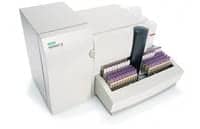Summary: Siemens Healthineers introduces Atellica Integrated Automation on the Atellica CI Analyzer, significantly reducing manual workflow steps in clinical laboratories by consolidating 25 tasks into one automated system.
Takeaways:
- Efficiency Gains: Atellica Integrated Automation reduces manual workflow steps by 75%, allowing laboratory professionals to focus on more value-added tasks.
- Space and Volume Adaptability: The automation system is suitable for labs with lower patient testing volumes or limited space, offering high-volume lab capabilities.
- Improved Patient Care: Automation reduces waste, increases throughput, and achieves faster turnaround times, enhancing the overall quality and efficiency of patient care.
Siemens Healthineers now offers Atellica Integrated Automation on the Atellica CI Analyzer,1 to consolidate 25 tasks typically handled manually by clinical laboratory staff. This offering has been shown to reduce the manual workflow steps laboratory professionals perform by 75%.2
Traditional total laboratory automation uses a track to transport patient samples throughout the laboratory to sample preparation equipment and then onto connected analyzers for testing. Atellica Integrated Automation incorporates sample management, decapper, and sealer functionality within the Atellica CI Analyzer. With Atellica Integrated Automation, laboratories with lower patient testing volumes or a finite amount of space in their laboratory now have access to automation capabilities incorporated primarily within high-volume testing or mega-labs.
Atellica Integrated Automation Fits Labs’ Specific Needs
Automation is increasingly important for labs of all sizes. Patient testing volumes continue to grow and so does the pressure on laboratory professionals to perform more patient testing with fewer staff. In the United States, vacancy rates in laboratories are estimated to be 7–11%, and as high as 25% in some geographies.3 The UK and Europe similarly face a serious shortage of skilled lab workers, with medical laboratories among the worst affected.4 For laboratories trying to maintain operations with fewer staff, Atellica Integrated Automation becomes laboratory professionals’ extra set of hands.
“Successful automation addresses the lab’s specific needs, while standardizing routine and repetitive tasks that safeguard quality and safety,” says Sharon Bracken, head of Diagnostics, Siemens Healthineers. “When it’s customizable, and implemented thoughtfully with input from key stakeholders, automation can save time, more efficiently produce quality test results, accommodate shifting testing demands, and eliminate biohazards for staff. All these improvements create a better working environment.”
To Hear More: Kids and Science: Is this THE Recipe for Solving the Laboratorian Shortage?
Necessary, yet repetitive, tasks that are performed to achieve quality patient test results cause friction in a laboratory’s workflow. Ninety-five percent of laboratory professionals indicated in a recent study that adopting automated technologies will help them improve patient care, and 89% agreed their laboratories need automation to keep up with demand.5 Further, time spent on maintenance undermines the clinical value laboratory staff can deliver. With Atellica Integrated Automation, a single technologist can manage calibration and QC, daily sorting, and archiving processes in minutes—tasks that historically may have taken hours. Fewer repetitive, manual tasks enable laboratory professionals to reallocate their time to value-add or growth activities, such as training and mentoring employees, or quality control efforts.
Atellica Integrated Automation Reduces Waste, Increases Throughput
Automating these processes also reduces waste, increases the number of samples a laboratory can run, and creates opportunity for laboratories to run a wider range of tests to support patient care as testing needs shift. Every time a patient sample is outsourced it creates obstacles for providing patients with the best care possible, including time delays, expense, and greater potential for errors. Optimized sample handling with Atellica Integrated Automation enabled 65% of samples to achieve faster turnaround times than competitor systems.2
“Regardless of volume, laboratory footprint, or geographic location, laboratory staff deserve technology that will help them overcome their laboratory’s current growth limitations and improve patient care in the communities they serve,” says Bracken.
Atellica Integrated Automation also supports laboratories with high testing volumes. The offering first became available on the company’s flagship analyzer, the Atellica Solution. Now, both the Atellica Solution and the Atellica CI Analyzer provide standalone automation capabilities with Atellica Integrated Automation or they can connect to track-based automation for expanded efficiency and throughput. More information about the Atellica Integrated Automation can be found here.
REFERENCES
1 Product availability varies by country and is subject to varying regulatory requirements. Future availability cannot be guaranteed. Please contact your local representative for availability.
2 Las Vegas Clinical Laboratory UMC Prioritizes STAT Runs, Streamlines Through Consolidation; Dark Daily Jan 2022. The outcomes achieved by the Siemens Healthineers customer described here were achieved in the customer’s unique setting. Since there is no typical hospital or laboratory, and many variables exist (e.g., hospital/laboratory size, case mix, level of IT adoption), there can be no guarantee that others will achieve the same results.
3 AACC Whitepaper on Overcoming Lab Staffing Shortages
4 Addressing the critical lack of skilled lab workers5 New Survey Reveals Burnout in Clinical Labs Impacts Patient Care, Staff Safety; Optimism that Automation, AI Will Help Tackle Challenges





